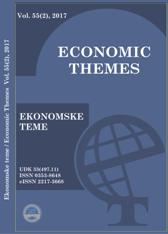Economic Themes (2017) 55 (2) 7, 263-280
Biljana Djordjević, Maja Ivanović-Djukić, Vinko Lepojević
Abstract: The purpose of this paper is to investigate the relationship between ages and gender of employees in organisations in Serbia and their job satisfaction. When it comes to age-job satisfaction relationship the assumption is that this relationship could be represented by the “U” curve. When it comes to gender-job satisfaction relationship the authors investigate whether there is a difference in the overall job satisfaction between men and women as well as whether there is a statistically significant influence of different job facets on job satisfaction of men and women in different ages in organisations in Serbia. For testing these assumptions descriptive statistics and multivariate analysis of variance were applied. The research methodology also included theoretical analysis of the concept of job satisfaction. Results of the study have shown that the level of job satisfaction of employees of different age cannot be represented by the “U” curve. Further, the results have shown that there is a small difference in the overall job satisfaction between men and women as well as that there are some dimensions of job that have statistically significant influence on job satisfaction of men and women in different ages. The practical implication of this paper is that it, based on the obtained results, suggests to the managers certain human resource management (HRM) practices in order to gain more satisfied and, hence, more productive employees.
Keywords: job satisfaction; age; gender; employees; organisations
RELATIONSHIP OF AGES AND GENDER OF THE EMPLOYEES IN ORGANISATIONS IN THE REPUBLIC OF SERBIA AND THEIR JOB SATISFACTION
Biljana Djordjević, Maja Ivanović-Djukić, Vinko Lepojević
Abstract: The purpose of this paper is to investigate the relationship between ages and gender of employees in organisations in Serbia and their job satisfaction. When it comes to age-job satisfaction relationship the assumption is that this relationship could be represented by the “U” curve. When it comes to gender-job satisfaction relationship the authors investigate whether there is a difference in the overall job satisfaction between men and women as well as whether there is a statistically significant influence of different job facets on job satisfaction of men and women in different ages in organisations in Serbia. For testing these assumptions descriptive statistics and multivariate analysis of variance were applied. The research methodology also included theoretical analysis of the concept of job satisfaction. Results of the study have shown that the level of job satisfaction of employees of different age cannot be represented by the “U” curve. Further, the results have shown that there is a small difference in the overall job satisfaction between men and women as well as that there are some dimensions of job that have statistically significant influence on job satisfaction of men and women in different ages. The practical implication of this paper is that it, based on the obtained results, suggests to the managers certain human resource management (HRM) practices in order to gain more satisfied and, hence, more productive employees.
Keywords: job satisfaction; age; gender; employees; organisations

